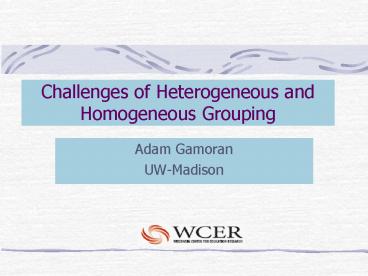Challenges of Heterogeneous and Homogeneous Grouping - PowerPoint PPT Presentation
Title:
Challenges of Heterogeneous and Homogeneous Grouping
Description:
Challenges of Heterogeneous and Homogeneous Grouping. Adam Gamoran. UW-Madison. Why Do Schools Assign Students to Classes by 'Ability'? Seems logical and efficient ... – PowerPoint PPT presentation
Number of Views:92
Avg rating:3.0/5.0
Title: Challenges of Heterogeneous and Homogeneous Grouping
1
Challenges of Heterogeneous and Homogeneous
Grouping
- Adam Gamoran
- UW-Madison
2
Why Do Schools Assign Students to Classes by
Ability?
- Seems logical and efficient
- Students differ in their performance levels, so
divide students to match instruction more closely
to their needs - A narrower range of student performance levels
makes it easier to organize the curriculum - So why is this problematic?
3
Problems of Ability Grouping
- Due to circumstances outside of school,
separating students by academic performance may
also separate them by race and social class - Homogenous classes lack the diversity that may
foster rich discussions
4
Problems of Ability Grouping
- Although ability grouping is intended to provide
equally effective instruction to all students,
that rarely occurs - Teachers are also tracked
- Cycle of low expectations
- Low-level classes as caricatures
- Emphasis on procedures in low-level classes,
discussion in high-level classes
5
Ability Grouping and Unequal Instruction
Track Level
Source Applebee, Langer, Nystrand, Gamoran,
2003.
6
Ability Grouping and Unequal Instruction
Track Level
Source Applebee, Langer, Nystrand, Gamoran,
2003.
7
Achievement Gaps between High and Low Tracks
Source Applebee, Langer, Nystrand, Gamoran,
2003.
8
Problems of Ability Grouping
- Partly as a result of unequal classroom
conditions, inequality between students assigned
to high- and low-level classes widens over time
9
Consequences of Ability Grouping
- No effect on achievement productivity
- Increase in achievement inequality
- Supporters focus on productivity while critics
emphasize inequality
10
Responses to the Problem
- Reduce the use of ability grouping
- Eliminate dead-end classes
- Avoid teacher tracking
- Maintain an academic curriculum with high
expectations and meaningful incentives in all
classes
11
Responses to the Problem
- Use mixed-ability grouping (heterogeneous
classes) - Help teachers prepare to teach mixed-ability
classes - Its too hard to do all of this.
12
Responses to the Problem
- Use mixed-ability grouping (heterogeneous
classes) - Help teachers prepare to teach mixed-ability
classes - Avoid diluting the curriculum
- Case studies Marble Canyon, Wallingford
13
Responses to the Problem
- Use mixed-ability grouping (heterogeneous
classes) - Help teachers prepare to teach mixed-ability
classes - Avoid diluting the curriculum
- Use differentiated assignments to challenge
high-achieving students
14
Cibola High A case of successful mixed-ability
teaching
- Complex academic projects
- Varied expectations for different students
- Curriculum not bound by a rigid sequence
- Supporting conditions
- Small classes
- Extra tutoring on Saturdays
- Selection of staff and students
15
Conclusions
- Eliminate dead-end courses.
- Where ability grouping is maintained, implement
high standards for low-achieving students. - Where ability grouping is eliminated, see that
standards for high-achieving students are not
lowered.
16
Conclusions
- Provide professional development for teachers to
help them meet the needs of all students.































